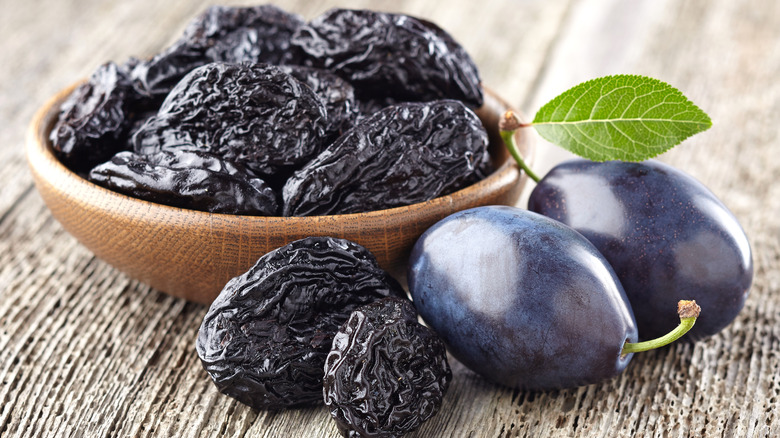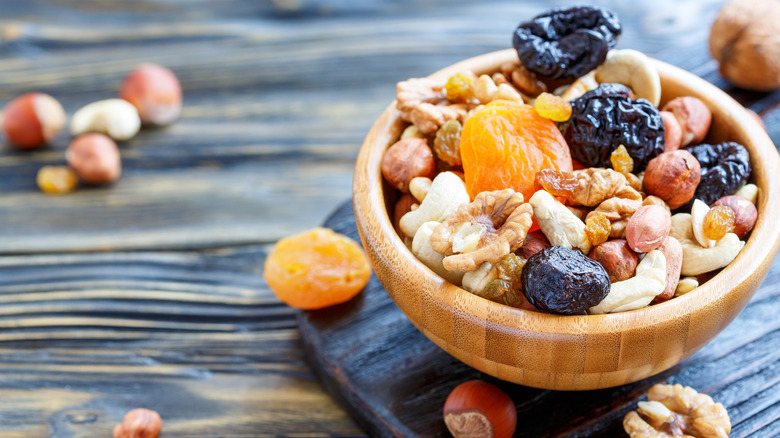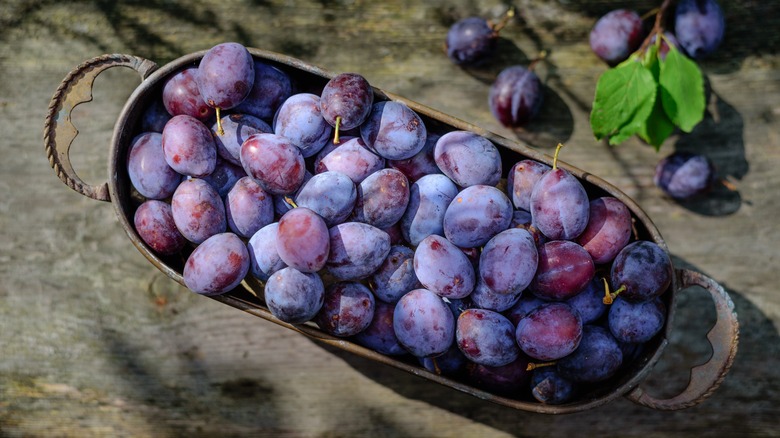What's The Difference Between Plums And Prunes?
You probably already know that prunes are good for your digestive health. In fact, if you've ever experienced some dietary distress, your older relatives probably suggested snacking on a handful of prunes or drinking a glass of prune juice. And there is a good reason for that. Prunes are famous for their high amount of insoluble fiber, as well as a sugar alcohol called sorbitol, which has been shown to help improve digestive health and relieve discomfort and constipation, according to Healthline. In fact, prunes contain about 15% sorbitol, compared to just one percent of the sugar alcohol found in fresh fruit, which is why prunes are often more effective than plums when it comes to relieving digestive distress, according to How Stuff Works.
But where exactly does this healthy fruit come from? Prunes are a dried fruit, similar to raisins, which are made when the ripe fruit is dehydrated. But although they are usually thought of as simply dried plums, the truth is a little more complicated than that. Although they may come from the same family, prunes and plums are not the same things. While it is true that prunes are a type of dried plum, not all plums can be turned into prunes.
Prunes come from a specific variety of plum
It turns out, prunes come from a very specific variety of plum, one that has an easily-removable pit, according to Difference Between. Prunes also differ in color from other plum varieties, bearing a rich blue or purple hue, rather than the deep red color of other ripe plums. Additionally, prunes tend to have an oval shape, while plums are usually rounder. However, both fruits are part of the same genus, Prunus, along with other stone fruits like cherries, apricots, and peaches.
Plums are usually eaten fresh. Dried prunes are made when the specific prune variety of plum is harvested and then pitted, dried, and steamed, according to Taylor Brothers Farms. Only the variety of plum that can undergo this dehydration process without fermenting can be turned into a prune. However, although prunes and plums are not exactly the same thing, in more recent years prunes have been marketed simply as "dried plums" in many cases, in order to avoid the unsexy association prunes have long had with their laxative effects and to make the food more appealing to a younger demographic.
Prunes and plums are a healthy addition to your diet
Plums and prunes both deliver a host of health benefits. Prunes, of course, are famous primarily for their fiber content, but plums also contain a healthy dose of the nutrient, although still about half as much as their plum counterparts, per Healthline. However, plums contain a higher dose of Vitamins A and C, while also delivering fewer calories and less sugar per serving.
But prunes are far from a one-trick pony. In addition to their high fiber content, they also contain a number of other nutrients, including Vitamin K and potassium, which can help improve bone health and even prevent loss of bone density (per How Stuff Works). Prunes are also a source of many essential B Vitamins, as well as other important minerals like copper, manganese, magnesium, and phosphorus.
Both prunes and plums derive their rich, deep color from antioxidants, which have been shown to help reduce inflammation and lower the risk of developing many serious health conditions, including heart disease, cancer, and diabetes, Healthline reports. So while prunes may be most famous for their role as a digestive aid, they deliver a number of benefits that your body will thank you for and taste great in recipes, too.


